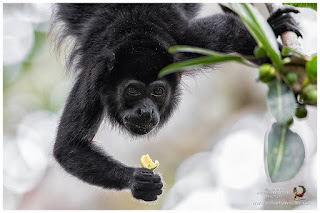Pipeline Road is not all about birds; during 2015 we also did a couple of nocturnal macro-adventures in which we captured, frogs, insects and spiders. We, as conservation photographers, try to capture everything that draws our attention in the field, and could represent a relative good photo. That includes any animal, small or large, and flora; therefore on our diurnal tours we were able to make the following pictures that hopefully you will also find interesting.
Mantled Howler Monkey (Alouatta palliata)
Wasp nest
All species of social wasps construct their nests using some form of plant fiber (mostly wood pulp) as the primary material, though this can be supplemented with mud, plant secretions (e.g., resin), and secretions from the wasps themselves; multiple fibrous brood cells are constructed, arranged in a honeycombed pattern, and often surrounded by a larger protective envelope. Wood fibers are gathered from weathered wood, softened by chewing and mixing with saliva.
Spectacled Caiman (Caiman crocodilus)
Crab
Rattlesnake Plant's inflorescence (Calathea crotalifera)
Ginger's flower (Renealmia cernua)
Black Iguana (Ctenosaura similis)
Common Basilisk (Basiliscus basiliscus)
Owl Butterfly (Caligo sp.)
Owl butterflies' underwing pattern is highly
cryptic. It is known that many small animals hesitate to go near patterns
resembling eyes with a light-colored iris and a large pupil, which matches the appearance of the eyes of many predators that hunt by sight. Several hypotheses are suggested to explain the occurrence of this kind of design as mimicry but certain researches suggest that eye-spots are not a form of mimicry and do not deter predators. In any case, the question why animals evolved such complex imitations is left unanswered.
To be continued...













Comments
Post a Comment